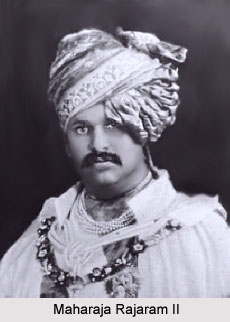 Rajaram II was the ruler or Maharaja of the princely state of Kolhapur, under the Deccan Division of the Bombay Presidency. At present Kolhapur is situated in the state of Maharashtra. He ascended the gadi or throne by succeeding his father Maharaja Shahu IV. He reigned over the territory of Kolhapur state from 31st July 1897 to 26th November 1940. Rajaram II was a benevolent sovereign, who was influential in the development and betterment of untouchable known as Dalits and other dejected castes in the princely state. The Maharaja of Kolhapur founded the Kolhapur High Court and established an efficient water supply system, modern housing developments, free primary education and higher level education for females and women.
Rajaram II was the ruler or Maharaja of the princely state of Kolhapur, under the Deccan Division of the Bombay Presidency. At present Kolhapur is situated in the state of Maharashtra. He ascended the gadi or throne by succeeding his father Maharaja Shahu IV. He reigned over the territory of Kolhapur state from 31st July 1897 to 26th November 1940. Rajaram II was a benevolent sovereign, who was influential in the development and betterment of untouchable known as Dalits and other dejected castes in the princely state. The Maharaja of Kolhapur founded the Kolhapur High Court and established an efficient water supply system, modern housing developments, free primary education and higher level education for females and women.
Rajaram II had only one daughter at the time of his death, thus he was succeeded by Shivaji V, who was a distant relative.
Titles of Rajaram II
Maharaja Rajaram II of the princely state of Kolhapur held various titles and styles through out his reign. These are discussed below-
* Shrimant Yuvaraja Rajaram II Chhatrapati Maharaj Bhonsle (1897- 1922)
* His Highness Kshatriya-Kulawatasana Sinhasanadhishwar, Shrimant Rajashri Rajaram II Chhatrapati Maharaj Sahib Bahadur, Maharaja of Kolhapur 1922- 1924)
* His Highness Kshatriya-Kulawatasana Sinhasanadhishwar, Shrimant Rajashri Sir Rajaram II Chhatrapati Maharaj Sahib Bahadur, Maharaja of Kolhapur, GCIE 1924- 1927)
* Lieutenant-Colonel His Highness Kshatriya-Kulawatasana Sinhasanadhishwar, Shrimant Rajashri Sir Rajaram II Chhatrapati Maharaj Sahib Bahadur, Maharaja of Kolhapur, GCIE (1927- 1931)
* Lieutenant-Colonel His Highness Kshatriya-Kulawatasana Sinhasanadhishwar, Shrimant Rajashri Sir Rajaram II Chhatrapati Maharaj
Sahib Bahadur, Maharaja of Kolhapur, GCSI, GCIE (1931- 1937)
* Colonel His Highness Kshatriya-Kulawatasana Sinhasanadhishwar, Shrimant Rajashri Sir Rajaram II Chhatrapati Maharaj Sahib Bahadur, Maharaja of Kolhapur, GCSI, GCIE (1937- 1940)
* Brigadier His Highness Kshatriya-Kulawatasana Sinhasanadhishwar, Shrimant Rajashri Sir Rajaram II Chhatrapati Maharaj Sahib Bahadur, Maharaja of Kolhapur, GCSI, GCIE (1940)
Honours of Rajaram II
Rajaram II, Maharaja of Kolhapur, was honoured a several times, which are mentioned as follows-
* Knight Grand Commander of the Order of the Indian Empire- GCIE (1924)
* Knight Grand Commander of the Order of the Star of India- GCSI (1931)
* King George V Silver Jubilee Medal (1935)
* King George VI Coronation Medal (1937)



















